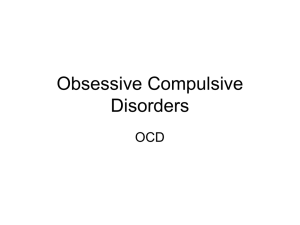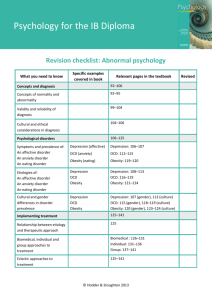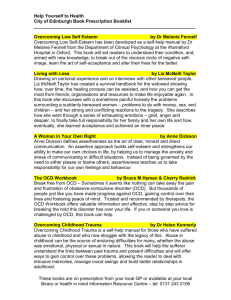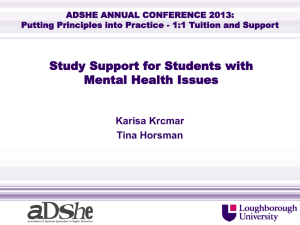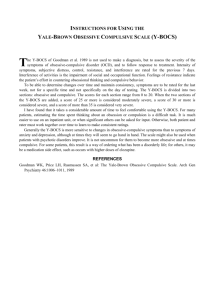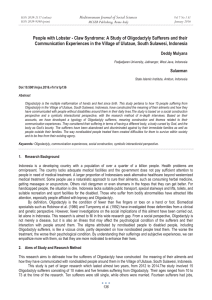here
advertisement
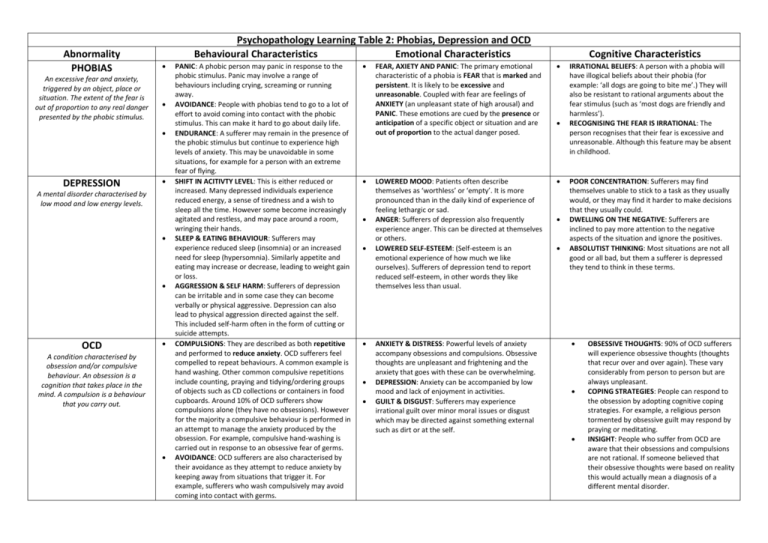
Abnormality PHOBIAS An excessive fear and anxiety, triggered by an object, place or situation. The extent of the fear is out of proportion to any real danger presented by the phobic stimulus. Psychopathology Learning Table 2: Phobias, Depression and OCD Behavioural Characteristics Emotional Characteristics DEPRESSION A mental disorder characterised by low mood and low energy levels. OCD A condition characterised by obsession and/or compulsive behaviour. An obsession is a cognition that takes place in the mind. A compulsion is a behaviour that you carry out. PANIC: A phobic person may panic in response to the phobic stimulus. Panic may involve a range of behaviours including crying, screaming or running away. AVOIDANCE: People with phobias tend to go to a lot of effort to avoid coming into contact with the phobic stimulus. This can make it hard to go about daily life. ENDURANCE: A sufferer may remain in the presence of the phobic stimulus but continue to experience high levels of anxiety. This may be unavoidable in some situations, for example for a person with an extreme fear of flying. SHIFT IN ACITIVTY LEVEL: This is either reduced or increased. Many depressed individuals experience reduced energy, a sense of tiredness and a wish to sleep all the time. However some become increasingly agitated and restless, and may pace around a room, wringing their hands. SLEEP & EATING BEHAVIOUR: Sufferers may experience reduced sleep (insomnia) or an increased need for sleep (hypersomnia). Similarly appetite and eating may increase or decrease, leading to weight gain or loss. AGGRESSION & SELF HARM: Sufferers of depression can be irritable and in some case they can become verbally or physical aggressive. Depression can also lead to physical aggression directed against the self. This included self-harm often in the form of cutting or suicide attempts. COMPULSIONS: They are described as both repetitive and performed to reduce anxiety. OCD sufferers feel compelled to repeat behaviours. A common example is hand washing. Other common compulsive repetitions include counting, praying and tidying/ordering groups of objects such as CD collections or containers in food cupboards. Around 10% of OCD sufferers show compulsions alone (they have no obsessions). However for the majority a compulsive behaviour is performed in an attempt to manage the anxiety produced by the obsession. For example, compulsive hand-washing is carried out in response to an obsessive fear of germs. AVOIDANCE: OCD sufferers are also characterised by their avoidance as they attempt to reduce anxiety by keeping away from situations that trigger it. For example, sufferers who wash compulsively may avoid coming into contact with germs. Cognitive Characteristics FEAR, AXIETY AND PANIC: The primary emotional characteristic of a phobia is FEAR that is marked and persistent. It is likely to be excessive and unreasonable. Coupled with fear are feelings of ANXIETY (an unpleasant state of high arousal) and PANIC. These emotions are cued by the presence or anticipation of a specific object or situation and are out of proportion to the actual danger posed. LOWERED MOOD: Patients often describe themselves as ‘worthless’ or ‘empty’. It is more pronounced than in the daily kind of experience of feeling lethargic or sad. ANGER: Sufferers of depression also frequently experience anger. This can be directed at themselves or others. LOWERED SELF-ESTEEM: (Self-esteem is an emotional experience of how much we like ourselves). Sufferers of depression tend to report reduced self-esteem, in other words they like themselves less than usual. ANXIETY & DISTRESS: Powerful levels of anxiety accompany obsessions and compulsions. Obsessive thoughts are unpleasant and frightening and the anxiety that goes with these can be overwhelming. DEPRESSION: Anxiety can be accompanied by low mood and lack of enjoyment in activities. GUILT & DISGUST: Sufferers may experience irrational guilt over minor moral issues or disgust which may be directed against something external such as dirt or at the self. IRRATIONAL BELIEFS: A person with a phobia will have illogical beliefs about their phobia (for example: ‘all dogs are going to bite me’.) They will also be resistant to rational arguments about the fear stimulus (such as ‘most dogs are friendly and harmless’). RECOGNISING THE FEAR IS IRRATIONAL: The person recognises that their fear is excessive and unreasonable. Although this feature may be absent in childhood. POOR CONCENTRATION: Sufferers may find themselves unable to stick to a task as they usually would, or they may find it harder to make decisions that they usually could. DWELLING ON THE NEGATIVE: Sufferers are inclined to pay more attention to the negative aspects of the situation and ignore the positives. ABSOLUTIST THINKING: Most situations are not all good or all bad, but them a sufferer is depressed they tend to think in these terms. OBSESSIVE THOUGHTS: 90% of OCD sufferers will experience obsessive thoughts (thoughts that recur over and over again). These vary considerably from person to person but are always unpleasant. COPING STRATEGIES: People can respond to the obsession by adopting cognitive coping strategies. For example, a religious person tormented by obsessive guilt may respond by praying or meditating. INSIGHT: People who suffer from OCD are aware that their obsessions and compulsions are not rational. If someone believed that their obsessive thoughts were based on reality this would actually mean a diagnosis of a different mental disorder.
